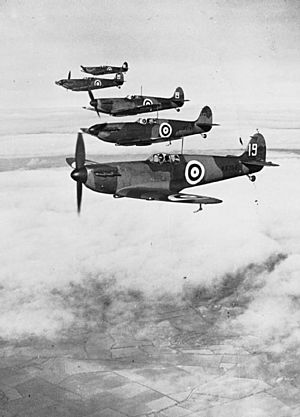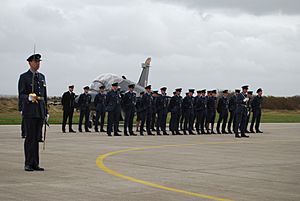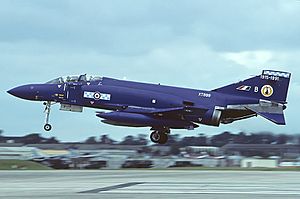No. 19 Squadron RAF facts for kids
Quick facts for kids No. XIX Squadron RAF |
|
|---|---|
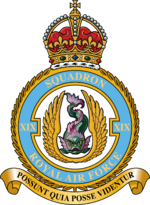
No. XIX Squadron badge
|
|
| Active | 1 September 1915 – 1 April 1918 (RFC) 1 April 1918 – 31 December 1919 (RAF) 1 April 1923 – 31 December 1976 1 January 1977 – 9 January 1992 23 September 1992 – 24 November 2011 1 April 2021– |
| Country | |
| Branch | |
| Type | Air Control Squadron, Ground-controlled interception |
| Role | Control and Reporting Centre |
| Size | 264 x Personnel |
| Part of | No. 2 Group RAF |
| Home station | RAF Boulmer |
| Nickname(s) | The Chosen Squadron; The Dolphins |
| Motto(s) | Latin: Possunt quia posse videntur (Translation: "They can because they think they can") |
| Colors | Sky Blue and White |
| Equipment | 1 x Operations Room 3 x AN/TPS-77 2 x AN/FPS-117 (Type 92) 1 x BAE Systems Type 102 1 x Indra Sistemas Lanza LTR-25 IBM Guardian Air Control System |
| Battle honours |
|
| Insignia | |
| Squadron Badge heraldry | Between wings elevated and conjoined in base, a dolphin, head downwards. |
| Squadron Roundel |  |
| Squadron Codes | WZ (Oct 1938 – Sep 1939) QV (Sep 1939 – Sep 1945) A (1989 – 1991) |
Number 19 Squadron (also known as No. XIX Squadron) is a special unit of the Royal Air Force (RAF). It made history by being the first squadron to fly the famous Supermarine Spitfire airplane.
Today, No. 19 Squadron helps control and report on air traffic from RAF Boulmer in the UK. They watch over UK airspace and guide RAF and NATO aircraft. This includes helping with the UK's part in NATO's Quick Reaction Alert mission, which means they are ready to respond quickly to any air threats.
The squadron was first created on September 1, 1915, as part of the Royal Flying Corps during the First World War. It was the first to use the Supermarine Spitfire for most of the Second World War. During the Cold War, the squadron flew many different jet planes, from the Gloster Meteor to the McDonnell Douglas Phantom.
No. 19 Squadron was temporarily stopped on November 24, 2011. But it was brought back on April 1, 2021. Now, it focuses on managing air battles and guiding NATO aircraft. This helps defend the UK and NATO airspace and trains RAF jet pilots.
Contents
History of No. 19 Squadron
First World War Service
No. 19 Squadron of the Royal Flying Corps started on September 1, 1915. It was formed from members of No. 5 Squadron at Castle Bromwich Aerodrome. They trained on various aircraft before moving to France in July 1916. There, they flew Royal Aircraft Factory B.E.12 planes and later switched to the faster French-built SPAD S.VIIs.
From November 1917, the squadron began to get Sopwith Dolphin planes. By January 1918, they were fully equipped with the Dolphin. Their first mission with the new fighter was on February 3. By the end of the war, No. 19 Squadron had 22 flying aces. These were pilots who had shot down five or more enemy aircraft.
Between the World Wars
No. 19 Squadron was stopped after the First World War on December 31, 1919. It was started again on April 1, 1923, at RAF Duxford. They first flew the Sopwith Snipe. The squadron stayed at Duxford and flew many different fighter planes. These included the Gloster Grebe, Armstrong Whitworth Siskin, and Bristol Bulldog.
In May 1935, the squadron became the first to use the Gloster Gauntlet. They flew these planes until March 1939. In 1938, No. 19 Squadron became the very first RAF squadron to fly the Supermarine Spitfire Mk.I. Their first Spitfire, K9789, arrived on August 4.
Second World War Role
No. 19 Squadron was at RAF Duxford when the Second World War began in September 1939. They were part of No. 12 Group, RAF Fighter Command. In May and June 1940, the squadron helped protect the ships and soldiers during the Dunkirk evacuation. This was when many Allied soldiers were rescued from France.
In June 1940, No. 19 Squadron started getting Spitfire Mk.Ibs. These planes had cannons, but they often had problems. So, the squadron soon went back to using the Spitfire Mk.Ia. No. 19 Squadron was also part of the 'Big Wing' formation during the Battle of Britain. This was a large group of planes that worked together to fight enemy aircraft.
Later, the squadron flew different versions of Spitfires. In early 1944, they started using North American Mustang Mk.IIIs. After D-Day, No. 19 Squadron briefly went to Europe. Then, they flew long-range escort missions from RAF Peterhead in Scotland. They protected Coastal Command aircraft off the coast of Norway. In April 1945, the squadron switched to the Mustang Mk.IV.
Cold War Operations

On May 13, 1945, No. XIX (Fighter) Squadron moved to RAF Acklington. They traded their Mustangs for Spitfire Mk.XVIs. In October 1946, at RAF Wittering, they switched to the de Havilland Hornet. In January 1951, the squadron received its first jet aircraft, the Gloster Meteor F.4. They soon got the Meteor F.8 in April 1951.
From October 1956, No. 19 (F) Squadron flew the Hawker Hunter F.6. In 1959, they moved to RAF Leconfield and switched to the English Electric Lightning F.2 in November 1962. In September 1965, the squadron and its sister unit, No. 92 (F) Squadron, moved to RAF Gütersloh in Germany. They later got the longer-range Lightning F.2A.
On December 31, 1976, No. 19 (F) Squadron stopped using the Lightning. The next day, it reformed at RAF Wildenrath with the McDonnell Douglas Phantom FGR.2. This plane was still used for air defence.
Because of limited airspace in West Germany, both No. 19 and No. 92 Squadrons often went to other places for training. They practiced missile firing in Wales and gunnery in Cyprus. They also took part in large international exercises in places like Florida and Nevada.
On August 17, 1990, No. XIX (F) Squadron and No. 92 (F) Squadron went to RAF Akrotiri in Cyprus. They provided air defence for the island. This was because other RAF planes had moved to Saudi Arabia due to the Iraqi Invasion of Kuwait. No. 19 (F) Squadron flew their Phantoms from Cyprus until February 28, 1991, when a ceasefire was called in the Gulf War.
On January 9, 1992, the squadron was stopped as part of plans to reduce military forces after the Cold War. Their aircraft were taken apart.
Hawk Training Role (1992–2011)
The squadron's number was then given to the former No. 63 Squadron in September 1992. This squadron flew Hawk planes at RAF Chivenor. It became No. 19 (Reserve) Squadron. When Chivenor stopped flying jets, the squadron moved to RAF Valley in September 1994. There, it provided advanced training for fast jet pilots using the BAE Hawk.
In 2011, it was decided that No. 19 Squadron's training role would be given to a new No. 4(R) Squadron. So, No. 19(R) Squadron, one of the last remaining squadrons from the Battle of Britain, was stopped on November 24, 2011. This was 96 years after it first began.
The event to mark the squadron's disbandment was held at RAF Valley. It was led by Wing Commander Kevin Marsh, the Officer Commanding No. 19 Squadron. Important guests included Air Chief Marshal Stephen Dalton and Flight Lieutenant Ken Wilkinson, a No. 19 Squadron Spitfire pilot from the Battle of Britain.
Control and Reporting Centre (2021 – present)
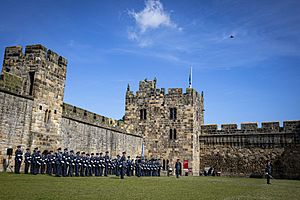
In 2021, the RAF recognized how important air traffic control and battle management units were. These units had defended the UK and NATO during the Cold War and after the 9/11 terrorist attacks. So, the RAF brought back squadron numbers for these units.
Battlespace Management Operations Wing became No. 19 Squadron on April 1, 2021. It continues to run the Control and Reporting Centre (CRC) from RAF Boulmer in Northumberland.
No. 19 Squadron's return was officially celebrated on June 15, 2021, at Alnwick Castle. The parade was led by RAF Boulmer Station Commander, Group Captain David Keighley, and the commanding officers of No. 19 and No. 20 Squadrons.
The CRC system helps operators understand what is happening in the air. It also lets them guide and advise military aircraft to complete their missions. No. 19 Squadron provides tactical Command and Control (Tac C2) for NATO.
Along with No. 20 Squadron, No. 19 Squadron continues to defend the UK. No. 20 Squadron trains the air battle managers for No. 19 Squadron. This includes initial training, combat readiness training, and a special course for Qualified Weapons Instructors.
Aircraft operated by No. 19 Squadron
| From | To | Aircraft | Version |
|---|---|---|---|
| September 1915 | October 1915 | Farman MF.11 Shorthorn | |
| September 1915 | October 1915 | Avro 504 | |
| September 1915 | October 1915 | Caudron G.3 | |
| October 1915 | December 1915 | Royal Aircraft Factory B.E.2 | c |
| December 1915 | December 1915 | Royal Aircraft Factory R.E.7 | |
| February 1916 | July 1916 | Avro 504 | |
| February 1916 | July 1916 | Caudron G.3 | |
| February 1916 | July 1916 | Bristol Scout | |
| February 1916 | July 1916 | Martinsyde S.1 | |
| February 1916 | July 1916 | Royal Aircraft Factory B.E.2 | c |
| February 1916 | July 1916 | Royal Aircraft Factory F.E.2 | b |
| February 1916 | July 1916 | Royal Aircraft Factory R.E.5 | |
| February 1916 | July 1916 | Royal Aircraft Factory R.E.7 | |
| June 1916 | February 1917 | Royal Aircraft Factory B.E.12 | |
| October 1916 | January 1918 | SPAD S.VII | |
| June 1917 | January 1918 | SPAD S.XIII | |
| November 1917 | February 1919 | Sopwith Dolphin | |
| April 1923 | December 1924 | Sopwith Snipe | |
| December 1924 | April 1928 | Gloster Grebe | |
| March 1928 | September 1931 | Armstrong Whitworth Siskin | Mk.IIIa |
| September 1931 | January 1935 | Bristol Bulldog | Mk.IIa |
| January 1935 | March 1939 | Gloster Gauntlet | Mk.I |
| September 1936 | February 1939 | Gloster Gauntlet | Mk.II |
| August 1938 | December 1940 | Supermarine Spitfire | Mk.I |
| June 1940 | September 1940 | Supermarine Spitfire | Mk.Ib |
| September 1940 | November 1941 | Supermarine Spitfire | Mk.IIa |
| October 1941 | August 1943 | Supermarine Spitfire | Mk.Vb |
| September 1942 | March 1943 | Supermarine Spitfire | Mk.Vc |
| August 1943 | January 1944 | Supermarine Spitfire | Mk.IX |
| January 1944 | April 1945 | North American Mustang | Mk.III (P-51 B/C) |
| April 1945 | March 1946 | North American Mustang | Mk.IV (P-51D) |
| March 1946 | November 1946 | Supermarine Spitfire | LF.16e |
| October 1946 | May 1948 | de Havilland Hornet | F.1 |
| March 1948 | January 1951 | de Havilland Hornet | F.3 |
| January 1951 | June 1951 | Gloster Meteor | F.4 |
| April 1951 | January 1957 | Gloster Meteor | F.8 |
| October 1956 | February 1963 | Hawker Hunter | F.6 |
| November 1962 | October 1969 | English Electric Lightning | F.2 |
| January 1968 | December 1976 | English Electric Lightning | F.2a |
| January 1977 | January 1992 | McDonnell Douglas F-4M Phantom | FGR.2 |
| September 1992 | November 2011 | BAe Hawk | T.1 / T.2 |
See also
- List of Royal Air Force aircraft squadrons


